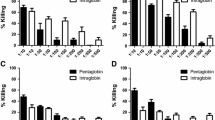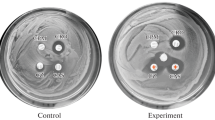Summary
Serum bactericidal activity (SBA) was studiedin vitro after intravenous administration of cefoperazone alone or in combination with mezlocillin or amikacin to human volunteers. One hour after the infusion, cefoperazone (2 g), cefoperazone + mezlocillin (5 g) and cefoperazone + amikacin (500 mg) achieved comparable activity againstEscherichia coli andKlebsiella pneumoniae (100% of the strains being killed by a 1:8 or greater dilution). The activity of the three regimens was also similar againstPseudomonas aeruginosa (87–96% of the sera had an SBA ≥ 1:8) and somewhat less forStaphylococcus aureus (52–60% with SBA ≥ 1:8). Six and ten hours after administration, the SBAs were much lower for all regimens; a small advantage for cefoperazone + mezlocillin againstK. pneumoniae could be shown in comparison to the other regimens.
Zusammenfassung
Die bakterizide Aktivität im Serum (SBA) wurde nach intravenöser Gabe von Cefoperazon allein oder in Kombination mit Mezlocillin oder Amikacin an freiwillige Probandenin vitro bestimmt. Eine Stunde nach der Infusion erreichten Cefoperazon (2 g), Cefoperazon + Mezlocillin (5 g) und Cefoperazon + Amikacin (500 mg) eine vergleichbare Aktivität gegenEscherichia coli undKlebsiella pneumoniae (bei einer Verdünnung von 1:8 oder darüber wurden 100% der Stämme abgetötet). Die Aktivität der drei Schemata war gegenPseudomonas aeruginosa vergleichbar (87–96% der Seren hatten eine SBA ≥ 1:8), fürStaphylococcus aureus etwas geringer (52–60% hatten eine SBA ≥ 1:8). Sechs und zehn Stunden nach Applikation waren die SBA-Werte für alle Dosierungen erheblich geringer; für die Kombination Cefoperazon + Mezlocillin konnte gegenK. pneumoniae eine gegenüber den anderen Therapieschemata geringfügige Überlegenheit festgestellt werden.
Similar content being viewed by others
Literature
Klastersky, J., Zinner, S. H. Synergistic combinations of antibiotics in gram-negative bacillary infections. Rev. Infect. Dis. 4 (1982) 294–301.
Young, L. S. Combination or single drug therapy for gram- negative sepsis. In:Remington J. S., Swartz M. N. (eds.): Current clinical topics in infectious diseases. Mc Graw-Hill Book Company New York, 1982.
EORTC International Antimicrobial Therapy Project Group Three antibiotic regimens in the treatment of infection in febrile granulocytopenic patients with cancer. J. Infect. Dis. 137 (1978) 14–29.
Gurwith, M., Brunton, J. L., Lank, B., Ronald, A. R., Harding, G. K. M., Mc Cullough, O. W. Granulocytopenia in hospitalized patients. II. A prospective comparison of two antibiotic regimens in empiric therapy of febrile patients. Am. J. Med. 64 (1978) 127–132.
Zinner, S. H., Klastersky, J., Gaya, H., Bernard, C., Ryff, J. C. In vitro andin vivo studies of three antibiotic combinations against gram-negative bacteria andStaphylococcus aureus. Antimicrob. Agents Chemother. 20 (1981) 463–469.
Klastersky, J., Daneau, D., Swings, G., Weerts, D. Antibacterial activity in serum and urine as a therapeutic guide in bacterial infections. J. Infect. Dis. 129 (1974) 187–193.
Bennet, J. V., Brodie, J. L., Benner, E. J., Kirby, W. M. Simplified accurate method for antibiotic assay of clinical specimens. Appl. Microbiol. 14 (1965) 170–177.
Reller, L. B., Stratton, C. W. Serum dilution test for bactericidal activity. II. Standardization and correlation with antimicrobial assays and susceptibility tests. J. Infect. Dis. 136 (1977) 196–204.
Coppens, L., Klastersky, J. Comparative study of anti-pseudomonas activity of azlocillin, mezlocillin and ticarcillin. Antimicrob. Agents Chemother. 3 (1979) 369–399.
Bergan, T. Overview of acylureidopenicillin pharmacokinetics. Scand. J. Infect. Dis. 29 Suppl. (1981) 33–48.
Bodey, G. P., Middleman, E., Umsawadi, T., Rodriguez, V. Infections in cancer patients. Results with gentamicin sulfate therapy. Cancer 29 (1972) 1697–1700.
Standiford, H. C., Viollier, A. F., Moody, M., Klastersky, J., Tatem, B., Schimpff, S. C. Antibiotic combinations against gram-negative bacilli andStaphylococcus aureus in cancer patients: comparativein vitro andin vivo activity of cefoperazone and mezlocillin singly or combined together. J. Antimicrob. Chemother. 9 Suppl. A (1982) 47–49.
Author information
Authors and Affiliations
Rights and permissions
About this article
Cite this article
Lagast, H., Klastersky, J., Standiford, H. et al. Comparative study of the serum bactericidal activity of cefoperazone alone and in combination with amikacin or mezlocillin against gram-negative bacilli and staphylococcus aureus. Infection 12, 190–193 (1984). https://doi.org/10.1007/BF01640897
Received:
Accepted:
Issue Date:
DOI: https://doi.org/10.1007/BF01640897




